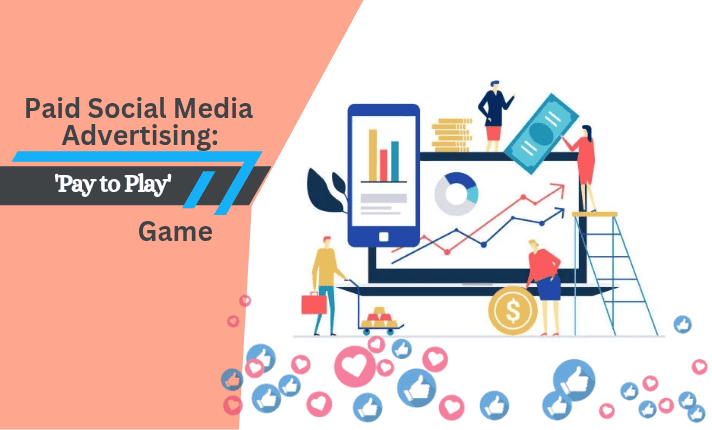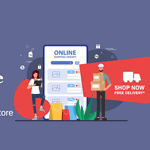Organic social media reach is declining rapidly every day on popular platforms like Facebook, YouTube and Instagram. This is why paid ads work better than organic social media posts.

With these constantly changing algorithms, relying solely on organic posts isn’t enough to increase your brand awareness among your users. So social media paid advertising is a great way to stand out and gain more influence from your visitors and convert them into customers.
Social media advertising allows you to target specific audiences, create your effective advertising format, and use data-driven tools to optimize your campaigns.
A well-planned social media strategy is the right choice to increase your brand awareness, increase sales and grow your business.
Let us know what the importance of is “Pay to Play” in the social media scenario. And how to leverage paid advertising to achieve your business goals:
Why do You Need ‘Pay to Play’
- Declining Organic Reach: Previously, popular platforms like Facebook and Instagram have allowed Brando to reach a large portion of their followers organically. However, organic reach has steadily declined as algorithms changed. Paid advertising removes these barriers and ensures that your content is seen by a larger audience, even if they are not your account followers.
- Targeting Audience: One of the biggest advantages of paid social media advertising is the ability to target very specific demographics. Here, you can narrow down your audience based on location, interests, behavior, age, and more. Targeting makes sure that your advertising money is spent on those people who are most likely to engage with your brand and become customers.
- Instant Result: Reaching out to people organically on social media is very slow and full of struggle. Paid advertising brings more immediate results. Once you start paid campaigns, it immediately increases traffic and engagement rates. This reason makes it an attractive option for businesses that want to generate quick results.
- Increase Visibility: Paid ads gives your content the opportunity to grow in a way that organic social posts never can. Even if you have few followers, paid advertising can help increase your visibility. Platform uses paid ads to ensure that your business content gets to the people who are most interested.
Key Platforms for Paid Social Media Advertising
In today’s digital landscape, social media advertising has become an essential component of a successful marketing strategy. Several key platforms stand out with their own unique capabilities and massive users base, making them a valuable resource for businesses looking to connect with their audience.
#1 Facebook & Instagram
The Meta company operates Facebook and Instagram which rank among the leading platforms for businesses to conduct paid advertising campaigns.
The ad tools of Facebook Ads Manager available to advertisers enable them to manage targeted campaigns that employ carousel ads and video ads and sponsored posts among other options through their combined 3 billion active users.
#2 X (Formally Twitter)
X, formerly known as twitter, is one of the most popular platforms for paid advertising. x Allow advertisers to be created using a variety of different formats, including image, video, text, or carousel advertisement.
Brand can also take advantage of the platform’s suite of advertising tools. Like amplify, which gives you the facility to add content in the relevant video your audience mostly watches.
Like other social media platforms, X provides a broad audience target and ensures that your social media advertising is seen by people who are likely to be interested in your product or service.
#3 LinkedIn
LinkedIn is a popular social media platform that is the most popular platform for your advertising to reach 950 million professionals.
This social media platform is an appropriate place to run paid social ads as it is capable of targeting experts, decision makers, officials, and industry experts.
Types of advertising on LinkedIn include in-feed advertising, sponsored messages, dynamic advertising (personalized advertising based on the user’s profile), and text advertising. And you can target campaigns to audience based on demographics, job title, security, company, and more.
#4 TikTok
By running a paid social media campaign on TikTok, you can gain engagement from highly engaged viewers and also increase sales. Because nearly 1 in 3 TikTok users want to purchase a product after seeing it on the platform.
So this is a strong signal for advertisers. TikTok is an effective place to run campaigns with the goal of increasing conversions.
TikTok has a wide choice of ad formats to promote businesses, including image, video, carousel, and shopping ads.
#5 Pinterest
For those businesses working in the fields of lifestyle, fashion, and home decor sectors, Pinterest is an excellent platform for paid advertising.
If your target audience meets the largest population group of women of the middle-to-upper class, then Pinterest is the best paid advertising for you.
Best Practice for Paid Social Media Advertising
1. Define Your Goals

Targeting your paid social media advertising is important to achieving success in your marketing efforts. Without goal setting up you could end up wasting valuable resources and missing out on potential returns.
First, you need to decide whether your goal is brand awareness, lead generation, or direct sales. Your objectives will determine your advertising strategy, budget, and targeting parameters
If you’re looking to increase visibility, focus on metrics like impressions and reach; doing so will help you understand how many people are viewing your ads. On the other hand, if your goal is to increase conversion rates, track click-through and conversion rates to assess effectiveness.
Additionally, it’s important to align your goals with the unique strengths of each social media platform. For example, platforms like Instagram are suitable for visual storytelling or brand engagement while LinkedIn is best for B2B lead generation.
2. Create Compelling Content

For an ad campaign to be successful, the content needs to be engaging, grab the user’s attention, and stand out from the crowd. An absolutely crucial aspect of creating effective content is understanding the platform and the user.
Invest in high-quality visuals, compelling copy, and clear a calls-to-action (CTA). Whether it’s an image, video or carousel, your entire content should be designed to stand out in a crowded feed and be compatible with your target audience.
- Read more: The Ultimate Guide to Write a Perfect Blog
3. Set a Realistic Budget

Setting a realistic budget is essential to achieve effective results in any marketing campaign. Paid social media advertising can be expensive, especially for new users. Set a budget based on your goals and make sure you’re tracking ROI to ensure you’re getting the most for your money.
While setting the budget for paid advertising, it is important to keep in mind various factors such as target audience, expectations and market competition. By setting objectives marker and realistic expectations can ensure that their budget is being used effectively to deliver the right vision and produce the desired results.
4. A/B Testing
A/B testing is a powerful tool for creating paid advertising in a specific situation on social media. The A/B testing is commonly known as split testing. This is a marketing technique where you test variations on the campaign by splitting your audience and determining which one performs better.
On social media, A/B testing provides real-time insights, allowing you to instantly test your strategies and create the best advertisement for a specific situation.
A/B testing is important for paid social media advertising success while keeping an eye on user behavior and constantly changing social media algorithms.
5. Report and Managing
Once a social media ad goes live, it’s important to monitor performance. You can use analytics to measure important metrics like click-through rate (CTR), conversion rate, and cost per acquisition (CPA).
Social media platforms provide real-time data so you can make changes to your campaigns for better results.
Challenges of Paid Social Media Advertising
Paid social media can give better results but it also brings with it some challenges which cannot be ignored. So let’s see what the challenges are:
#1 Ad fatigue: You need to regularly update your advertising content on social media platforms and adjust the targeting. Because if viewers watch the same material repeatedly, they can become indifferent to your advertisement.
#2 Cost fluctuations: The cost of advertising on social media can fluctuate depending on demand, competition and targeting. For example, bids for ad placement can increase in competitive places or during a pick-time, so it’s important to keep an eye on your budget and adjust accordingly.
#3 Ad relevance: Platforms will penalize ads that are not relevant and engaging to the target audience. Because low quality ads and poorly targeted campaigns can yield poor results.
Conclusion: The ‘Pay to Play’ Strategy
Social media advertising is actually a ‘pay to play’ game that, if played correctly, can be a great source of revenue. With the ability to reach target audience, drive immediate results and increasing visibility, paid ads is a powerful tool in your marketing arsenal.
However, to get maximum benefit from your advertising expenditure, it is important to follow the best practices, constantly adapt your campaigns, and adapt to changes in the trend in social media.
Finally, whether you are a small business or a large entrepreneur, investing in paid social media is an important strategy to stay competitive in the digital age.


